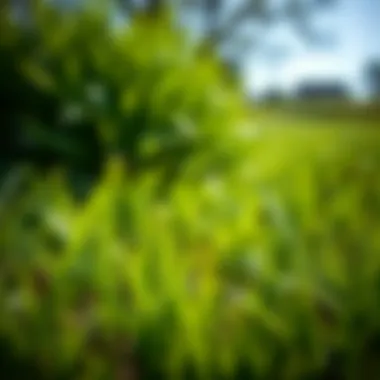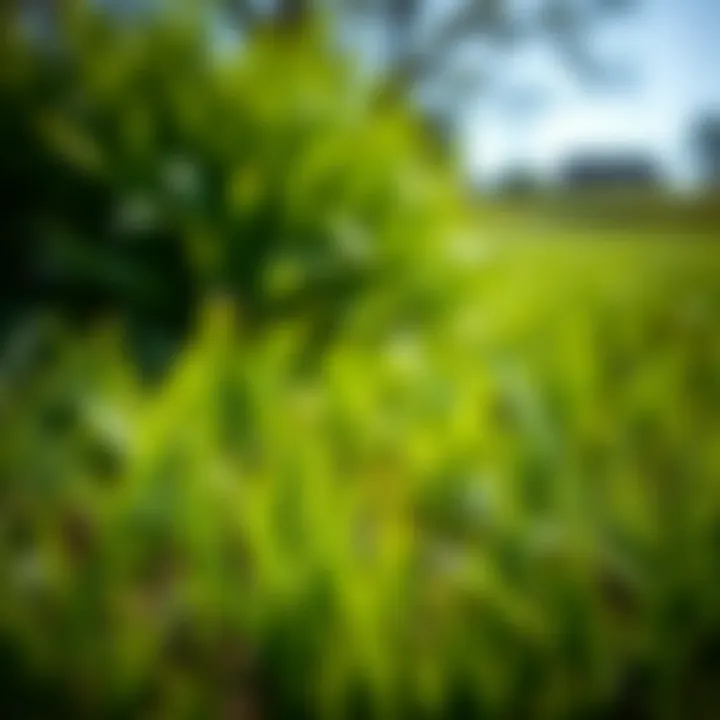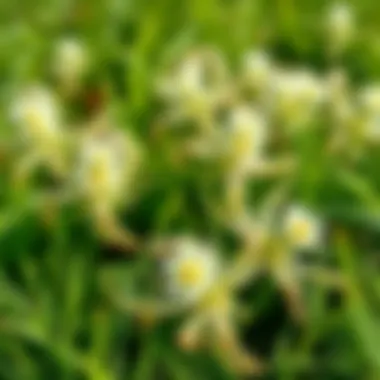Effective Strategies to Eliminate Crabgrass from Lawns


Intro
Crabgrass, an unwelcome guest in many lawns, can turn lush greenery into unsightly patches of coarse texture. As any seasoned gardener or homeowner will tell you, battling crabgrass is no small feat. This resilient weed, known scientifically as Digitaria spp., thrives in various conditions, proliferating rapidly and choking out more desirable grass species.
Understanding the why's and how's behind crabgrass growth is essential for anyone wanting to maintain a pristine lawn. The urge to uproot it could be strong, but a well-planned approach is what leads to success.
This guide will lay out effective strategies, combining prevention techniques and removal tactics, so that your lawn remains a vibrant green oasis. Not only will you learn different methods—both organic and chemical— but also the importance of cultural practices in keeping your lawn healthy for the long haul.
For the sake of clarity, the article is divided into several crucial areas:
- Key Concepts and Terminology: A look at what crabgrass is and its historical context.
- Recent Innovations and Trends: Exploration of new technologies and sustainable practices that aid in the fight against this invasive weed.
- Practical Applications and Techniques: Step-by-step guides and case studies to illustrate successful crabgrass control.
By the end of this piece, you will not only be equipped with the knowledge necessary to effectively combat crabgrass but also a deeper understanding of how maintaining your lawn can enhance not just aesthetics but overall yard health.
Understanding Crabgrass
Crabgrass poses a significant challenge for many lawn enthusiasts and farmers, making it imperative to understand this invasive weed in depth. Recognizing the characteristics, life cycle, and the overall impact of crabgrass on your lawn is crucial for effective removal and prevention strategies. Without this foundational knowledge, efforts to combat crabgrass may feel like pushing a boulder up a hill—exhausting and often futile.
Characteristics of Crabgrass
Crabgrass, scientifically known as Digitaria, is characterized by its wide, flat leaves which can spread out across the ground. Typically, you'll notice its growth during the warm months, particularly in late spring to early summer. It’s often a light green and tends to grow in patches, taking over wherever the soil is bare or stressed.
- Growth Form: Unlike many desirable grasses that grow upright, crabgrass sprawls along the ground. This sprawling nature allows it to capture sunlight and water more effectively than surrounding grasses, further giving it a competitive edge.
- Leaf Structure: The leaves are usually wider than common lawn grasses and have a distinct ribbed appearance, which makes them easily identifiable.
"By understanding what crabgrass looks like, you can better plan your attack before it takes over your lawn."
Life Cycle of Crabgrass
To effectively manage crabgrass, one must consider its life cycle. Crabgrass thrives in cycles that are closely tied to temperature and moisture levels in the soil. Understanding these cycles allows for timely interventions.
- Seed Germination: Crabgrass seeds often germinate in soil temperatures ranging from 55°F to 60°F, which typically happens in late spring. During this period, they push through the surfance quickly if there is adequate moisture.
- Vegetative Growth: Once established, crabgrass can grow rapidly. It'll spread aggressively, reaching maturity in approximately six to eight weeks. After this period, it will produce its own seeds that can multiple the issue further the following seasons.
- Seed Lifespan: Additionally, crabgrass seeds can remain dormant in the soil for years. This means that just because you think you’ve cleared it out, doesn’t mean that it’s truly gone for good.
Why Crabgrass is Problematic
The presence of crabgrass can lead to a multitude of issues within your lawn. Its characteristics and growth patterns contribute to its notoriety as a persistent weed type. Understanding the specific problems it presents can inform your management strategies.
- Competition: Crabgrass competes with your desired grass for essential resources such as water, nutrients, and light. This often leads to weaker grass and potentially more patchy appearances.
- Reduced Aesthetic Value: Crabgrass can detract from the visual appeal of a well-maintained lawn. A lush, emerald green lawn is often disrupted by the untamed look of a crabgrass invasion.
- Difficult to Eliminate: Once established, it becomes increasingly difficult to remove crabgrass. Even after pulling it, the remaining seeds can sprout and flare up the problem again. A proactive rather than reactive approach is always advisable.
Understanding these aspects of crabgrass gives you a clearer picture of how to approach both its removal and long-term prevention in your lawn care strategy. Managing this invasive plant requires diligence and an informed approach, integral to maintaining not just the beauty, but the health of your lawn.
Identifying Crabgrass Infestation
Identifying crabgrass infestation is critical in maintaining a healthy lawn. If left unchecked, this resilient weed can undermine the vigor of your grass and turn your green oasis into a patchy mess. Recognizing the signs early not only helps you take appropriate measures but also aids in preventing future outbreaks. By becoming acquainted with the specific visual cues and the timing of their emergence, lawn owners can keep this stubborn invader at bay.
Visual Signs of Crabgrass
Crabgrass can be a tricky foe. Its appearance differs from the lush grass you wish to cultivate. Here are some visual signs to help you spot these pesky weeds:
- Leaf Structure: Crabgrass has wider leaves compared to most turf grasses, and they usually grow in a distinct clump or tuft formation. This growth pattern resembles an unruly mane that differentiates it from the rest of your lawn.
- Color: During its early stages, crabgrass appears light green but can turn brown or yellow as it matures. Pay close attention to any color mismatches that may hint at an invasion.
- Seed Heads: Look for tall spikes with small flowers in the summer months. If you notice sudden spikes in your lawn, it's likely crabgrass throwing a party.
Recognizing these signs quickly can save time and resources, leading to a more effective eradication process.
Timing the Identification
Timing is everything when it comes to dealing with crabgrass. Identifying the weed at the right moment maximizes your chances of successful control. Generally, crabgrass germinates when soil temperatures reach around 55 degrees Fahrenheit—usually in spring. Here's how to time your observations:
- Early Spring Vigilance: Start inspecting your lawn in early spring. Keeping tabs on soil temperature lets you preemptively spot the weed's first signs before they become an overwhelming problem.
- Watch for Germination Patterns: As the weather warms up, take note of any unusual growth patterns. The earlier you identify crabgrass, the easier it is to manage it; if you spot it during its germination phase, you have options to tackle it before it takes over.
- Seasonal Considerations: Remember that crabgrass behaves differently in various regions and climates. In northern areas, it can appear as late as summer, while southern regions see it much sooner. Adjust your vigilance according to local seasonal changes.


"Early detection of crabgrass truly is the best medicine. If you catch it young, it’s often a walk in the park to manage, unlike dealing with a full-grown invasion."
By knowing the specific signs and paying attention to when they appear, you can position your lawn for success against crabgrass. Keep your eyes peeled, and your lawn will flourish without the interference of this opportunistic weed.
Cultural Practices for Prevention
Preventing crabgrass is all about understanding how the grass grows and how to outsmart it. By adopting certain cultural practices, homeowners can create an environment that discourages crabgrass while simultaneously promoting healthier grass species. This holistic approach not just saves time and effort in tackling this pesky plant but also nurtures the overall health of your lawn. Here are some crucial elements and considerations when implementing preventive practices.
Mowing Techniques
One of the simplest yet most effective strategies to keep crabgrass at bay is mowing. However, it’s not just about cutting your grass; it's about how you do it. Here are some essential tips:
- Mow High: Keeping your mower blades set high, typically around 3 inches or more, allows established grass to shade the soil. This shade can suffocate any potential crabgrass seeds, which prefer sunny spots.
- Sharp Blades: Ensure the mower blades are sharp. Dull blades can tear grass rather than cut it cleanly, creating openings for pests and diseases.
- Vary Your Patterns: Changing your mowing pattern each time you mow can prevent soil compaction and promote healthy growth. Crabgrass thrives in compacted areas.
"Mowing regularly and correctly can keep your lawn looking lush while making it harder for crabgrass to make an appearance."
Watering Strategies
Watering is another critical component in crafting a crabgrass-resistant lawn. Insightful watering practices can bolster your primary grass and weaken crabgrass.
- Water Deeply but Infrequently: Aiming for about 1 to 1.5 inches of water per week encourages deep root growth. Shallow watering just washes the surface, benefitting crabgrass more than your primary lawn.
- Early Morning Watering: Water in the early hours when temperatures are cooler. This helps reduce evaporation and ensures the grass has ample time to dry, minimizing the risk of fungal diseases.
- Observe Weather Patterns: Adjust your watering schedule based on rainfall conditions. Over-watering can lead to weak grass, making it easier for crabgrass to infiltrate your lawn.
Fertilization Schedule
A well-planned fertilization schedule can significantly bolster your lawn's defenses against crabgrass. Here’s how to optimize it:
- Choose the Right Fertilizer: Utilizing a slow-release nitrogen fertilizer strengthens the grass over time, making it less susceptible to invasion. It promotes overall health without encouraging excessive growth that can lead to a weaker lawn.
- Timing is Key: Fertilize at the beginning of the growing season to give your lawn a boost. Avoid fertilizing late in the season, as it might encourage growth that’s vulnerable to winter stress.
- Soil Testing: Consider performing a soil test to understand nutrient deficiencies. This practice will help you tailor your fertilization plan to your lawn’s specific needs, thereby maximizing benefits.
Incorporating these cultural practices creates a fortress around your lawn, deterring crabgrass while nurturing the grass you want. With diligent attention to mowing, watering, and fertilization, you can establish a lush, healthy lawn that effectively counters the invasive tendencies of crabgrass.
Physical Removal of Crabgrass
Removing crabgrass by hand can sometimes be the best option when tackling a small infestation. This strategy speaks to the importance of directly dealing with the problem rather than waiting for chemicals or other treatments to do the bulk of the work. Physical removal secures immediate results, stops the spread of the weed, and is environmentally friendly. Knowing when and how to remove crabgrass can transform your lawn from a patch of weeds into a vibrant green space.
Manual Pulling Techniques
Manual removal of crabgrass is a straightforward but effective method. Begin by selecting the right conditions; wet soil makes it easier to pull the plant up by its roots. Namely, pulling when the soil is moist allows for deeper roots to be extracted, minimizing regrowth. When you approach the plant, grasp the base of the crabgrass stem between your thumb and fingers. Pull upwards gently, ensuring that you remove as much of the root as possible. If you don’t pull out the roots, the crabgrass will simply come back, ready to take over once more.
Consider wearing gloves to protect your hands, especially if you have sensitive skin. It’s also helpful to work in small sections, focusing on one area of your lawn at a time. This allows for greater concentration, reducing the chances of missing small sprouts hiding amidst the grass.
You might want to keep a bucket nearby to collect removed plants, keeping your lawn tidy. Think of it like cleaning your room and putting the clutter away instead of just shoving it under the bed.
Using Tools for Assistance
Sometimes, our hands alone aren’t enough, especially with stubborn roots. Here’s where tools come into play, helping to ease the physical effort and enhance your effectiveness. A hand trowel or a weed puller can be a game changer.
A weed puller, particularly, is designed to penetrate the soil, loosening the roots while providing grip. Position the tool next to the base of the crabgrass and push down into the soil, twisting and pulling as you lift. Ensure you’re angled so the root detaches cleanly from the ground rather than breaking off. Tools might sound impersonal, but think of them as a pair of extra hands that help you get the job done more efficiently.
In tackling larger areas, tools like a hoe can assist in uprooting more plants at once but require a keen eye to avoid damaging surrounding grass. After using any tool, make sure to clean it before moving on to another task. You wouldn't want to transfer any unwanted seeds or soil remnants back to a cleaned area, after all.
Effective physical removal can greatly reduce a crabgrass population, decreasing future infestations.
In summary, the physical removal of crabgrass is one of the most pivotal aspects of lawn maintenance. Using both manual techniques and tools in combination raises your chances of success significantly. Understand the importance of diligence in this area, as a little effort can lead to lasting improvements in the overall health of your lawn.
Organic Solutions to Control Crabgrass
Attempting to control crabgrass organically offers a multitude of benefits, particularly for homeowners who are striving to maintain a healthy, chemical-free lawn. These methods not only assist in managing crabgrass but also promote overall soil health and biodiversity, which are critical for sustainable gardening. Organic approaches minimize chemical runoff into water sources, reduce toxicity for pets and humans, and contribute to a robust ecosystem within your yard.


In this section, we'll delve into two specific organic methods: creating homemade herbicides and employing beneficial ethnobotanical practices. Both techniques prioritize natural ingredients and holistic practices that herald the cries for a greener approach to lawn care.
Homemade Herbicides
Making your own herbicide at home can be quite simple and cost-effective. Many common household items act as catalysts in curbing crabgrass growth while being less harmful to the environment.
Here’s a basic recipe worth considering:
- Vinegar: Acetic acid in vinegar can kill young crabgrass plants when applied directly. Use a concentration of 10% if you have it on hand; regular white vinegar at 5% may work, albeit at a slower pace.
- Salt: Adding salt to steeped vinegar can enhance the overall efficacy. However, exercise caution as salt can harm neighboring plants and soil quality if overused.
- Dish soap: A small amount of dish soap acts as a surfactant, helping the solution stick better to the leaves of the crabgrass.
To produce the herbicide, mix one cup of vinegar with a tablespoon of salt and a few drops of dish soap. Pour the mixture into a spray bottle and target the crabgrass during midday when sunlight is strong. Be meticulous to avoid desirable plants, as this solution does not discriminate between harmful and beneficial flora.
"An ounce of prevention is worth a pound of cure."
This homemade concoction serves as a quick fix and should be used alongside other preventions to effectively manage crabgrass.
Beneficial Ethnobotanical Methods
Turning to ethnobotanical techniques, we find that many cultures possess ancient wisdom regarding plant utilization that can aid in controlling crabgrass. These methods often rely on plants and botanical compounds known to disrupt the life cycle of crabgrass without the use of synthetic chemicals.
- Corn Gluten Meal: This natural herbicide prevents crabgrass from germinating when applied pre-emergent in spring. It acts as a natural pre-emergent and provides nitrogen to the soil. Applying it at a rate of about 20 pounds per 1,000 square feet a few weeks before expected crabgrass emergence can be remarkably effective.
- Mulching: Using organic materials as mulch can suppress crabgrass seeds by blocking sunlight. Consider layers of straw, wood chips, or shredded leaves. Not only does this method inhibit weed growth, but it adds nutrients back into the soil as it decomposes.
- Clover Cover Crops: Planting clover can help by outcompeting crabgrass for resources. Clover also improves soil structure and enriches it through nitrogen fixation.
Adopting these organic solutions will necessitate patience and consistent application, but the rewards of a health-promoting, eco-friendly lawn are well worth the effort. Implementing a combination of these techniques may vastly improve your chances of reclaiming control over your lawn in the long run.
Chemical Herbicides: An Overview
When it comes to tackling the stubborn presence of crabgrass in your lawn, chemical herbicides can play a pivotal role. Understanding their application not only helps in effective management but also allows you to preserve the health of your lawn in the long run. By choosing the appropriate herbicide type, you can ensure that your control methods are efficient and tailored to the specific stage of crabgrass infestation.
Key Benefits of Chemical Herbicides
- Targeted Action: These herbicides are formulated to target specific weeds, such as crabgrass, without harming your existing grass.
- Speed of Action: Chemical solutions often show results more quickly compared to organic methods. This can be crucial during peak growth seasons when swift action is needed.
- Broader Range of Impact: Some herbicides can effectively manage multiple types of weeds, not just crabgrass, making them versatile for other lawn care issues.
Considerations
While chemical herbicides present several advantages, it’s wise to approach their use with caution:
- Environmental Concerns: Chemicals can leach into the soil and water supply, potentially harming local ecosystems. It’s essential to consider the broader environmental impact.
- Resistance Development: Just as bacteria can develop resistance to antibiotics, weeds can adapt to herbicides over time, diminishing their effectiveness. Rotating different types of herbicides may help mitigate this risk.
- Proper Timing: Applying herbicides at the wrong time—too early or too late—can lead to ineffective treatment and waste of resources.
"Use herbicides wisely. Though they can be powerful allies, overuse or misuse can cause more harm than good."
Closure
In summary, chemical herbicides can be a valuable component of a comprehensive crabgrass management strategy, provided that their use is informed by a solid understanding of their types and application methods. Next, let’s dive deeper into the two main categories that can help you keep your lawn healthy and crabgrass-free: pre-emergent and post-emergent herbicides.
Creating a Long-Term Strategy
Developing a long-term strategy to fight crabgrass is not just smart; it is essential for those who want their lawn to thrive over time. Many homeowners rush into treatments, only to find the pesky grass returning each season with a vengeance. A long-term approach focuses on sustainable practices that enhance lawn health, making it less susceptible to crabgrass invasions.
Understanding Soil Health
Healthy soil is the backbone of a flourishing lawn. To effectively combat crabgrass, cultivating good soil biology is key. Begin by testing your soil pH; most grass types prefer a pH between 6 and 7. If the pH is off, crabgrass can outcompete your desired grass. Incorporating organic matter like compost enriches the soil, enhancing its structure and drainage, which is vital for grass roots. Well-aerated soil also encourages beneficial microorganisms, which help break down nutrients, allowing them to be readily available for your grass.
Life in the soil doesn’t stop there. Mycorrhizal fungi and other life forms can create symbiotic relationships with grass roots, allowing for better nutrient uptake. By taking the time to foster and maintain these relationships, you're investing in a lawn that can stand strong against crabgrass and other invasive species down the line. Moreover, adding mulch can help retain moisture and further improve soil quality, ensuring that your lawn remains robust even in the toughest weather conditions.
Maintaining Lawn Density
A denser lawn is less inviting for crabgrass. By promoting thick, lush grass, you are providing less opportunity for crabgrass to take root. This can be achieved through proper mowing techniques; cutting at the right height (around three inches) will encourage deep root growth and discourage weed growth. Also, regularly overseeding your lawn with quality grass seeds can help bolster density. Choose a seed mix tailored to your local environment, as this can significantly improve your chances of establishing a resilient lawn.


During the spring and early fall, taking steps to fertilize appropriately will bolster grass growth as well. A well-timed fertilization schedule helps grass outcompete any invading weeds, including crabgrass. Be wary of over-fertilizing, as this can lead to excessive growth, making your grass more vulnerable to pests and diseases. Understand that consistency is crucial; set up a maintenance plan to keep your lawn's density at optimal levels year-round.
Let’s not forget about the role of irrigation in maintaining density. During dry spells, it’s essential to water wisely and deeply. Shallow watering can lead to shallow roots, making your grass susceptible to drought and more tender to competition from crabgrass. Aim to give your lawn an inch of water each week, either from rainfall or supplemental sources.
The grass is always greener where it’s well-fed and cared for.
Monitoring and Maintenance
Monitoring and maintenance are crucial elements in the battle against crabgrass. By consistently observing your lawn and making necessary adjustments, you can prevent crabgrass from taking hold and ensure your turf remains healthy and vibrant. Regular upkeep helps in early detection of any infestations, making it easier to manage and mitigate the problem before it escalates.
Regular Lawn Inspections
Regular inspections of your lawn should become a part of your outdoor routine. This practice allows you to spot early signs of crabgrass or other weeds while they're still manageable. Walk through your yard and observe any discolored patches or unusual growth patterns. The best times for these inspections are late spring and early summer when crabgrass typically begins to emerge.
During your walkthrough, take note of the following:
- Patchy Areas: Uneven growth may indicate that crabgrass is establishing itself.
- Seed Head Formation: Look for the seeds that take a 'contrarian' approach—standing taller than your actual lawn grass.
- Soil Health: Consider the moisture and nutrient levels in your soil, as drought or poorly fertilized areas are inviting to crabgrass.
By being proactive and identifying these signs early, you can adopt effective strategies to address the issue without resorting to drastic measures.
Seasonal Adjustments
As seasons change, so do the needs of your lawn. Making seasonal adjustments is essential for maintaining your lawn's health and combating crabgrass. Different seasons bring varying conditions that affect growth rates, moisture levels, and the likelihood of weed outbreaks.
Spring
- Prepare your lawn for the warm months by aerating the soil and applying a pre-emergent herbicide, if needed. This can help prevent crabgrass seeds from germinating.
- Ensure you begin your fertilization schedule in early spring to promote healthy grass growth.
Summer
- Keep the grass mowed to the proper height to outcompete crabgrass. Taller grass shades the soil, preventing crabgrass from getting the sunlight it requires.
- Adjust your watering practices: during dry spells, ensure your lawn receives deep watering, so the grass roots grow stronger and are more resilient against weeds.
Fall
- After summer’s end, address any crabgrass that may have taken hold. You might find it beneficial to reseed or overseed your lawn as colder months approach; this will help in thickening the turf.
- Maintain a strong fertilization program that prepares your grass for winter, ensuring it’ll return vibrant in spring.
Effective monitoring and timely seasonal adjustments set the stage for a thriving lawn, minimising challenges posed by crabgrass.
By staying vigilant and adopting seasonal care strategies, you create a healthy lawn environment that is less inviting to crabgrass. The focus should always be on resilience through understanding the lawn’s needs, ensuring a beautiful green space free from unwanted visitors.
Closure
In addressing the issue of crabgrass presence in lawns, it’s essential to consider the broader context of maintaining a healthy growing environment. Crabgrass is more than just a nuisance; it compromises the aesthetic quality and overall health of your lawn, hindering the growth of more desirable grass species. The significance of effectively removing crabgrass cannot be overstated, especially for those who take immense pride in their outdoor spaces.
Summarizing Key Points
The roads to success in crabgrass eradication center around understanding and proactive management. Let’s recap the critical elements:
- Knowledge is Key: Recognizing the characteristics and life cycle of crabgrass helps in timely identification and intervention.
- Cultural Practices: Practices such as precise mowing, intelligent watering, and a well-timed fertilization schedule can prevent crabgrass from taking root in the first place.
- Physical Removal: Hand-pulling or using tools when the soil is damp can effectively reduce the spread of existing crabgrass patches.
- Organic and Chemical Solutions: Evaluating homemade herbicides or commercially available pre-emergents can suit varying lawn situations while ensuring effectiveness.
- Long-Term Strategy: Creating a plan that emphasizes soil health and lawn density is crucial for future resilience.
- Ongoing Monitoring: Regular inspection and timely adjustments ensure that you stay a step ahead of these pesky invaders.
In essence, a well-informed strategy combines immediate action with long-term foresight.
Encouraging Sustainable Practices
This article advocates for a balanced approach to crabgrass management, integrating both chemical and organic methods. To foster a healthier lawn ecosystem, consider the following sustainable practices:
- Choose Native Plants: Native grasses are more likely to withstand local pests and diseases, reducing the need for chemical interventions.
- Soil Testing: Regular testing helps understand nutrient needs, preventing over-fertilization, which can fuel weed growth.
- Companion Planting: Integrating different plant species can naturally deter crabgrass and enhance overall lawn health.
- Mulching: Apply organic mulch to suppress weed growth and maintain soil moisture, creating a less hospitable environment for crabgrass.
- Biological Control: Explore the use of beneficial insects or natural herbicides to address crabgrass without harming the environment.
"Sustainable lawn care not only benefits the landscape but also contributes to a greener planet."
In summary, grasping the importance of effective crabgrass management within sustainable frameworks not only enhances your lawn's vitality but also aligns with environmentally friendly practices. For more insights, check sources like Wikipedia, Britannica, and local agricultural extensions at *.gov.
By boosting knowledge and implementing a diversified approach, you can maintain a lawn that remains vibrant and healthy, while also contributing positively to the surrounding ecosystem.















